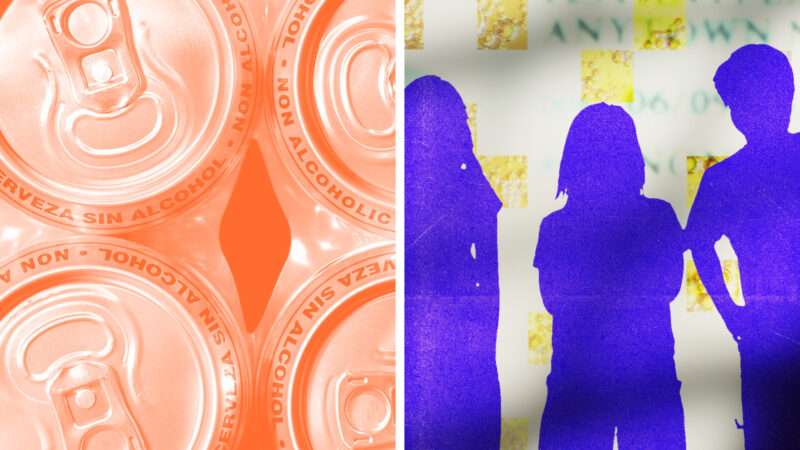
If you walk into a grocery store and pick up a six-pack of nonalcoholic beer, you might be caught off guard by an unexpected request to show your ID to the cashier. As a matter of inventory protocol, nonalcoholic beers are often categorized under similar stock-keeping unit (SKU) numbers as regular beer, which can result in a would-be buyer automatically getting carded at the register. But what might be an occasional, if annoying, quirk of modern retailing could soon become a government mandate.
Various "experts" are calling on state governments to impose age restrictions on the sale of nonalcoholic drinks, according to CNN. This is being pushed under the guise of protecting against underage alcohol consumption, based on the argument that products like nonalcoholic beer could be a gateway to the real thing. The reality is that imposing age restrictions on nonalcoholic beverages could actually result in more youth drinking, not less.
The experts quoted by CNN cite research surveys conducted abroad that supposedly show that youths who drink nonalcoholic beverages are more likely to also drink alcoholic beverages. One of the studies, for instance, polled Japanese adolescents and found consumption of nonalcoholic beverages "was strongly associated with alcohol use in high school students."
This sounds pretty damning until one reads the next sentence of the researchers' conclusions, in which they have spectacularly buried the actual results of their work: "concerns that [nonalcoholic beverage] use would lead to increased alcohol use were not supported because [nonalcoholic beverage] consumption usually started after adolescents began consuming alcohol" [emphasis added]. In other words, the adolescents first started drinking booze, then started drinking alcohol-free options, not vice versa.
Perhaps expecting journalists, much less researchers themselves, to understand the difference between correlation and causation is too high of an ask, but it only gets worse. A researcher from Australia is also interviewed about focus groups and surveys he conducted of Australian youth drinking and the potential interplay of nonalcoholic beverages. According to the researcher, "a few teens mentioned they had gotten used to the taste of beer by drinking zero alcohol versions, which suggests that zero alcohol beverages can acclimatise young people to the taste of alcoholic beer."
Setting aside the obvious evidentiary shortcomings of what "a few teens" said in a focus group, a look at the final research paper provides as much or more evidence that teenagers are using nonalcoholic beverages in place of alcoholic beverages, rather than as an on-ramp to real drinking. Although the researchers note that "respondents who consumed alcohol [were] 1.8 times more likely to use [nonalcoholic beverages] compared to alcohol abstainers," it again was admitted that alcohol use could have preceded any use of nonalcoholic alternatives.
More interestingly, the results also show that teenagers are incredibly deft in their ability to substitute nonalcoholic beverages in lieu of actual booze—and in fact use the availability of nonalcoholic alternatives to circumvent peer pressure to drink the hard stuff. Of the adolescents surveyed, 63 percent said nonalcoholic beverages could help individuals drink less alcohol, while 54 percent said such drinks could enable people to pretend they are drinking alcohol when they are not. Another 51 percent said nonalcoholic drinks made it easier for underage individuals to say no to alcohol, and 45 percent agreed they allowed underage people to "fit in" with others who were drinking alcohol.
In reality, teenagers are doing exactly what many a parent would want them to do: find ways to creatively sidestep peer pressure from friends and older acquaintances who might push them to drink. In fact, it turns out that by far the most common way the teens surveyed procured nonalcoholic beverages was from their parents.
While no nationwide studies of American youths have been attempted, the states CNN lists as having more stringent age restrictions on nonalcoholic drinks (such as Florida, Georgia, Idaho, and Kansas) have not seen noticeably different changes in youth drinking rates than those without such restrictions.
Lost in this discussion is any mention of numbers that show a decadeslong decline in youth drinking. In America, underage drinking rates have plummeted since the 1980s. Gen Zers are already being labeled as a notoriously antibooze generation and their nonalcoholic preferences correlate with the rise of the "sober-curious" and "mindful mixology" movements, which emphasize no-alcohol or low-alcohol alternatives to the fully leaded stuff. (It should also be pointed out that no ID is required to buy products like kombucha, which contain trace amounts of alcohol that can sometimes even exceed that of nonalcoholic beer).
It's almost like—just as the surveys from teens themselves suggest—the free market of nonalcoholic beverage options is helping reduce underage drinking, not increase it. Clamping down on access to nonalcoholic drinks could worsen the very problem it is intended to solve.
The post Mandatory ID Checks for Nonalcoholic Beer? appeared first on Reason.com.







